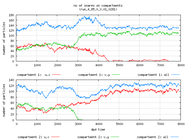Intracellular differentiation with DPD transport vesicles and DPD SAMs
Heinrich's model addresses the differentiation of intracellular compartments to separate identities based on exchange of proteins via transport vesicles.
The elementary processes of vesicle budding and fusion are biassed by specific coat proteins and Snare proteins.
The Heinrich model is a set of ordinary differential equations describing the dynamics of two-compartments, two types of transport vesicle coats (A,B), two SNARE pairs (X,U and Y,V) and one cargo (C). The original program calculates the time dependent changes of compartment sizes and transport vesicle quantities with different coats, and of the amounts of SNAREs and cargo in compartments and vesicles, starting with initial values for these variables until a steady state is reached.
Our work extending Heinrich's model and linking it to more realistic simulations:
In our simulation all constituents are represented by DPD particles. The compartments are build by mprDPD particles forming balls fixed in space by some (5) unmovable water particles in their center. The SNARE pairs (X,U and Y,V) are modeled by one single particle respectively as well as the transport vesicles in their different states. On budding or fusion of vesicles from/to the compartments particles change their type between mprDPD and simple DPD.



